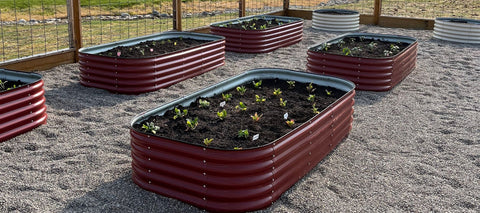The Abundant Rewards of Growing Tomatoes in Garden Beds
Garden beds are a delightful space that allows individuals to connect intimately with nature and reap the satisfying rewards of their labor. Among the various choices for planting in a garden bed, tomatoes stand out as a wise selection, offering not only delicious produce but also a myriad of advantages. In this article, we will delve into why planting tomatoes in the garden bed is a preferred option and explore the numerous benefits they bring.

First and foremost, garden beds provide an ideal environment for growing tomatoes.
These raised, well-defined plots of soil offer better drainage, ensuring that excess water does not accumulate around the roots. Tomatoes are susceptible to rot and fungal diseases when their roots remain waterlogged, making garden beds an excellent choice to mitigate such risks and promote healthy growth.
The elevated structure of the garden bed allows for better air circulation around the plants.
Adequate airflow is essential for preventing humidity build-up and minimizing the chances of various tomato diseases, such as blight. By reducing the risk of disease, garden beds provide a stable and reliable setting for tomatoes to thrive throughout the growing season.
Garden beds offer the advantage of customizability in soil quality.
Gardeners can meticulously amend the soil with compost and other organic matter, creating a nutrient-rich foundation that encourages strong root development and abundant fruiting. Unlike traditional in-ground planting, where soil conditions may be less controllable, the tailored approach of garden beds significantly enhances tomato plants' overall health and productivity.
The versatility of garden beds extends to their practical benefits for maintenance and care.
The defined boundaries of a garden bed make it easier to manage and control weed growth. With fewer weeds competing for resources, tomato plants can focus their energy on growth and fruit production. Additionally, the ability to easily access the garden bed for maintenance tasks reduces the need to step on the soil where tomatoes are planted. This minimizes soil compaction, which is crucial for ensuring the roots have enough space to breathe and access essential nutrients.
The beds offer the opportunity to implement season-extending strategies effectively.
Gardeners can take advantage of the raised bed's heat-retaining properties by adding a layer of organic mulch or using row covers during cooler nights. The increased warmth around the tomato plants can prevent frost damage and help them thrive during early spring or late autumn, potentially extending the growing season and yielding more luscious tomatoes.
In addition to their practical benefits, garden beds also foster creativity in gardening techniques like companion planting.
Pairing tomatoes with compatible companion plants, such as basil or marigolds, can promote biodiversity, deter pests, and enhance the flavors of tomatoes. Such synergistic planting strategies are more easily implemented in garden beds, where space can be organized and utilized efficiently.

In conclusion, growing tomatoes in the garden bed offers numerous benefits that make them a popular choice for gardeners. The controlled environment of garden beds ensures proper drainage, optimal soil conditions, and enhanced air circulation, all of which contribute to healthier tomato plants. The reduced weed competition and better access for maintenance simplify care efforts and promote higher yields of delicious tomatoes. Additionally, the versatility of garden beds allows for the implementation of various gardening techniques, like season-extending methods and companion planting, further enriching the overall gardening experience. So, if you're planning to grow tomatoes, consider the garden bed as your canvas to cultivate a thriving and bountiful tomato patch.
